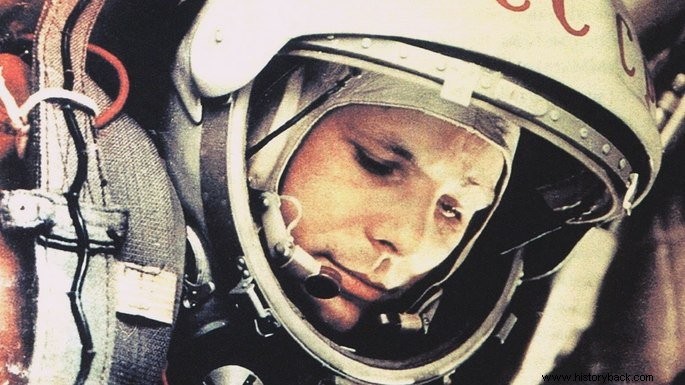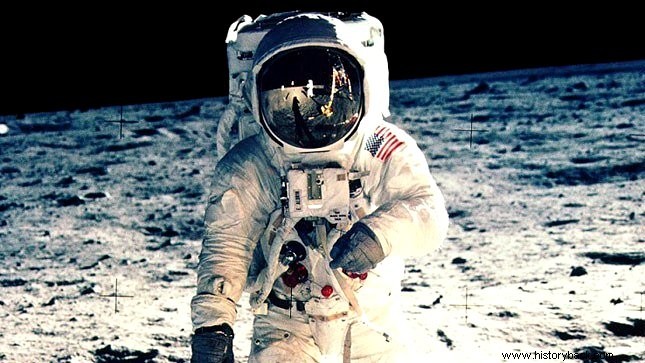The space race , which began in 1957, was a technological competition between the Soviet Union and the United States for the conquest of Earth orbit.
The objective was to develop technology that would allow the construction of the first manned spacecraft in orbit and the arrival on the Moon.
The Space Race and the Cold War
With the end of World War II, the United States and the Soviet Union ceased to be allies and began to vie for political and economic influence in the world.
They began to confront each other indirectly in peripheral territories, but also in the field of culture, sports and technology. However, they never faced each other directly in any military conflict and, therefore, this period was called the Cold War.
One of the most visible faces of this dispute was the Space Race. This consisted in the development of vehicles that were capable of flying over the Earth's orbit and, who knows, going further into space. Likewise, it was thought to build a shield that would protect each nation from the enemy country's missiles.
For studies and technological development, the governments of both countries recruited the best scientists and engineers from Germany, who were unemployed after the 1939-1945 conflict.
See also:Cold War:features, causes and consequencesSpace Race Summary
Although the two countries had the same technical and operational capability, the Soviets were the first to put a satellite into orbit.
Soviet space program

The Soviets were the first to send the Sputnik I satellite into space on October 4, 1957. The Russian action was interpreted by the Americans as a challenge, and four months later, the US put Explorer I into orbit.
Efforts to send humans on the ships would follow, and for that, tests were carried out with animals such as the dog Laika, in 1957, and two other dogs and mice in 1963.
With the success of this latest mission, the Soviets prepared to transport humans into space. Thus, the cosmonaut Yuri Gagarin (1934-1968), on April 12, 1961, was able to contemplate the Earth beyond orbit, crewing the Vostok I spacecraft.
Two years later, the Soviet Union would send the first woman into space, Valentina Vladimirovna Tereshkova, on June 16, 1963.
If the Americans looked more and more at the Moon, the USSR began to focus more on the possibilities of colonizing space and this was done with the first Space Station, launched in 1971. That year, three cosmonauts spent three weeks there carrying out experiments.
The Soviets even sent probes to Mars (1971) and Venus (1972) putting aside the dream of reaching the Earth satellite.
See also:Sputnik satellitesAmerican Space Program

Three months after the launch of Sputnik, the US launched the Explorer I satellite on January 31, 1958, which remained active, sending meteorite information, until May of the same year.
However, Yuri Gagarin's mission once again made the United States feel overwhelmed. Domestic political pressure increased in the United States in the face of Russian performance and the Americans considered themselves ashamed for not leading the space race.
Thus, in 1961, President John Kennedy (1917-1963) announced in Congress that the US would be the first country to land a man on the moon through the Apollo Moon project.
At the same time, the Gemeos Program was launched, responsible for the development of a spacecraft capable of making human beings land and return safely. A year later, on February 20, 1962, John Glenn orbited Earth aboard the spacecraft Friendship 7.
The success of the research was demonstrated on July 20, 1969, when Neil Armstrong (1930-2012) set foot on lunar soil after a three-day trip together with astronauts Buzz Aldrin and Michael Collins.
The Americans would still send six more manned missions that would land and bring moonstones to be analyzed by scientists.
See also:Apollo 11End of the Space Race
Several reasons put an end to the space race. One of the reasons was the increase in fuel prices, with the first oil crisis in 1973, which significantly increased production costs.
Also a diplomatic approach between the two powers, started in the 70s, with the aim of ending the Cold War. In addition to the meetings between the presidents, cooperation between the Soviet and American space agencies began.
The result was the Apollo-Soyus project where the American Apollo and Soviet Soyus spacecraft met and docked in space on July 17, 1975. It was the end of the space race.
Although the mission was a success, the program did not go ahead and the two nations would not cooperate on space programs again until the 1990s.
See also:Man's Journey to the MoonArms Race
The term Arms Race is used to demonstrate the behavior of governments that increase in a short time the quantity and quality of war instruments in times of peace.
The first contemporary arms race took place when France and Russia challenged British naval superiority in the late 19th century.
It was Germany's attempt to overcome Britain's might that culminated in World War I.
The first agreement to limit the accumulation of weapons was signed in Washington to address the tension between the United States, Britain and Japan.
When the struggle for power in space began between the two countries, the expression "race" was used again, but this time, with the term "space" to differentiate it from the first.
See also:
- Cold War Questions
- Arms Race
